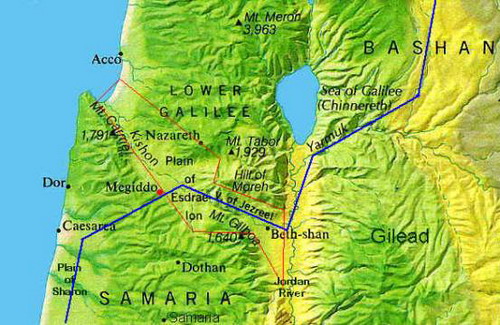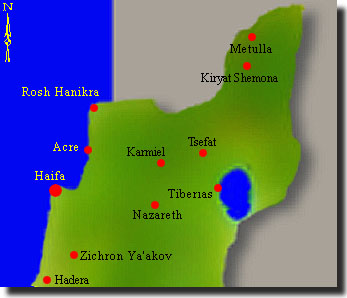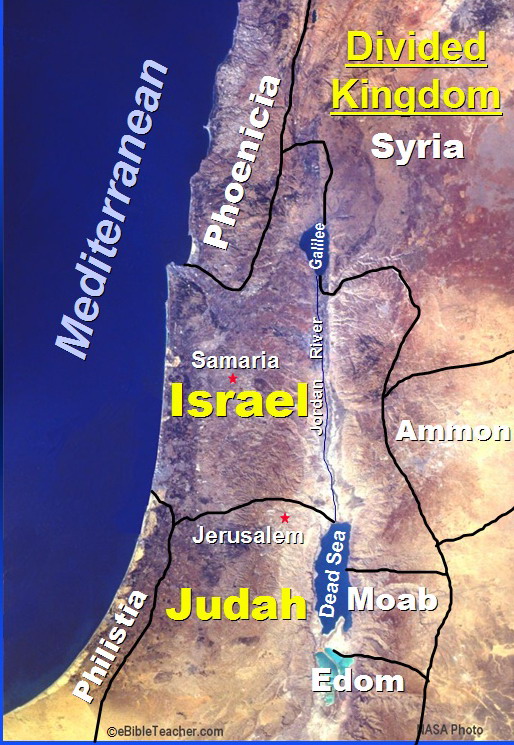|
The Brit-Am Rose |
|
The Brit-Am Rose |
|
Brit-Am Discussion Group |
Contents by Subject |
Research Revelation Reconciliation Contribute |
|
Site Map Contents in Alphabetical Order |
This Site |
|

|
 |
|
##
(1) Ahab Extracts: http://en.wikipedia.org/wiki/Ahab From Wikipedia, the free encyclopedia Extracts: Ahab (or Ach'av or Achab in Douay-Rheims or Hebrew: , Modern A av Tiberian A , A ; "Brother of the father") was king of Israel and the son and successor of Omri (1 Kings 16:29-34). William F. Albright dated his reign to 869 " 850 BC, while E. R. Thiele offered the dates 874 " 853 BC.[1] Ahab married Jezebel, the daughter of King Ithobaal I of Tyre, and the alliance was doubtless the means of procuring political support. Shalmaneser III's (859-824 BC) Kurkh Monolith names King Ahab. During Ahab's reign, Moab, which had been conquered by his father, remained tributary; Judah, with whose king, Jehoshaphat, he was allied by marriage, was probably his vassal; only with Aram Damascus is he believed to have had strained relations. Battle of Qarqar The Battle of Qarqar is one event mentioned by external sources and was perhaps at Apamea where Shalmaneser III of Assyria fought a great confederation of princes from Cilicia, Northern Syria, Israel, Ammon and the tribes of the Syrian desert (853 BC). Ahab's contribution was reckoned at 2,000 chariots and 10,000 men. The numbers are comparatively large and possibly include forces from Tyre, Judah, Edom, and Moab. The Assyrian king claimed a victory, but his immediate return and subsequent expeditions in 849 BC and 846 BC against a similar but unspecified coalition seem to show that he met with no lasting success. According to the Tanakh, however, Ahab with 7,000 troops had previously overthrown Ben-hadad and his thirty-two kings, who had come to lay siege to Samaria, and in the following year obtained a decisive victory over him at Aphek, probably in the plain of Sharon at Antipatris (1 Kings 20). A treaty was made whereby Ben-hadad restored the cities which his father had taken from Ahab's father (that is, Omri, but see 15:20, 2 Kings 13:25), and trading facilities between Damascus and Samaria were granted. Three years later, war broke out on the east of the Jordan River, and Ahab with Jehoshaphat of Judah went to recover Ramoth-Gilead. During this battle Ahab disguised himself but was shot by an arrow and mortally wounded (ch. 22). ## He was succeeded by his sons, Ahaziah and Jehoram. ################################################### (2) Ahab Jewish Virtual Library http://www.jewishvirtuallibrary.org/jsource/biography/Ahab.html (born c. 853 - BCE Reigned c. 874"c. 853 BCE) Extracts: Ahab whose name means "The Father is My Brother", i.e. "God is my close relative" (Pfeiffer, 1988: 40), owed much of his success to his father Ormi"s efforts to set the Northern Kingdom on a firm political foundation. Omri founded Samaria, the third capital of the Northern Kingdom in his 7th year (c. 880 BC). Jeroboam had chosen Shechem, a place of with ancient associations with the patriarchs Abraham (Gen. 12:6) and Jacob (Gen. 33:18). Later the capital had moved to Tirzah, about 7 miles to the north-east of Shechem." (Bruce, 1983: 43). Omri bought the hill of Samaria from Shemer for 2 shekels of silver (1 Kings 16:24), and increased its natural advantages by fortification. Samaria was built on an isolated hill, 90m [300 ft] in height, connected with the surrounding hill country only by a saddle to the east and surrounded by a fertile valley (Isa. 28:1, 4) (Van Selms, 1988: 296). The strength of Samaria can be gauged by the number of sieges it withstood against well-equipped armies during its 150 year history. It took the Assyrians three years to capture it (725-722 BC). The city could control the trade routes to the North, East and West to the Valley of Esdraelon. Omri made Samaria the property of the Kings of Israel; technically not subject to the tribes and their popular gatherings, but only to the King and local authorities (Van Selms, 1988: 296) as David had done for Jerusalem. The Moabite Stone records that Moab was subjugated by Israel during the reign of Omri (something that Scripture does not mention) (Prichard, 1955, 320-321). Some measure of his success can be gained when reading Shalmanesser III's account of the tribute he received from Jehu (841-814 BC) (1 Kings 19:16-17). Shalmanesser refers to Jehu as "the son of Omri". Although not physically descended from him by this time the Royal house of Israel was known internationally by the name of its most famous member. Omri was as far thinking politically as he was strategically. By the time his son Ahab acceded to the throne in 874 BC he had already cemented his father"s alliance with Phoenicia by marrying Jezebel daughter of Ethbaal, the priest-king of Tyre. ...He [i.e. Ahab] later arranged the marriage of his daughter Athaliah to Joram, crowned prince of Judah, sealing an alliance with their father Jehoshaphat. This marriage was to have serious religious consequences; for Athaliah had imbibed her mother's Baalism, which later led to a crisis in Judah (see 2 Kings 11). Joint operations between Ahab and Jehoshaphat were equally ill-fated. Their trading venture, again reminiscent of Solomon's (1 Kings 9:26-28), was brought to an abrupt halt when the entire fleet was wrecked before it had even set sail (2 Chron. 20:35-37; 1 Kings 22:48). Joint military operations also ended in disaster (1 Kings 22:29-38). Jezebel's patronage of the cults of Ba'al and Asherah led Ahab into direct confrontation with one of the greatest of the prophets, Elijah. He appeared suddenly before the king and defied Ba'al by declaring that by his word alone would there be either rain or dew in the land (1 Kings 17:1). Before Ahab could detain him Elijah was gone and despite an international search Elijah remained hidden (18:9). After three years Elijah sought out the king, who was now searching for grass for his horses (18:5-6). Obadiah, who was in charge of Ahab's palace, brought him word of where Elijah was to be found and when they met Ahab accused him of being a "troubler of Israel." Ben Hadad, King of Aram aided by 32 of his vassals attempted to capture Samaria. Initially it appears that Ahab was prepared to surrender to him and accept the lose of his wives and possessions (20:1-7). Ben Hadad, however, appears to have wanted a fight and so made his demands so unreasonable that Ahab had no choice but to refuse them and prepare for a siege (20:9-12)...Ben-Hadad was finally captured by Ahab's inferior forces after being defeated at Aphek in the plain of Jezreel the following year. ...the states of Israel, Aram, Hamath and nine other smaller powers were forced to unite against the growing power of Assyria, which had been impotent for almost two centuries due to the attacks of Aramean nomads. From 900 BC onwards the power of Assyria swept westwards and in 853 Shalmaneser III faced the coalition of Syrian and Cilician states at Qarqar on the Orontes river. According to Shalmaneser's own records Ben-Hadad fielded 20 000 soldiers, and Ahab 10 000 soldiers and 2 000 chariots. Shalmaneser claims a sweeping victory; the corpses of his foes, he says, covered the plain of the Orontes and dammed the stream itself [Pritchard, 1955: 277-281]. But the fact that he did not pursue his alleged advantage and returned home and did not return for 12 years suggests that the confederates gave a good account of themselves." (Bruce, 1983: 47, brackets mine). The size of the force that Ahab fielded is ample proof that he was the most powerful king in the history of the Northern kingdom (Hoerth, 1998: 313). After the Assyrian threat had been vanquished, for a time at least, the alliance soon broke up and war resumed between Israel and Aram. Following the Battle of Qarqar Ahab called upon his ally Jehoshaphat [of Judah] to aid him in his struggle with Ben Hadad. ...Despite entering battle in disguise Ahab was finally slain by a stray arrow (22:1-34). At the last he appears to have shown real courage in remaining propped up in his chariot until he died from lose of blood, to delay the dispersal of his troops when they saw that he was dead (22:34-36). Ahab was succeeded by his son Ahaziah (1 Kings 22:40). He had ruled Israel for 22 years.## |
|
Asherah
pole http://en.wikipedia.org/wiki/Asherah_pole An Asherah pole is a sacred tree or pole that stood near Canaanite religious locations to honor the Ugaritic mother-goddess Asherah, consort of El. Maypole
http://en.wikipedia.org/wiki/Maypole Dancing around the maypole, in "meberg, Sweden The maypole is a tall wooden pole ...erected to celebrate May Day or Midsummer...With roots in Germanic paganism, the maypole traditionally appears in most Germanic countries. Maypole dance http://en.wikipedia.org/wiki/Maypole_dance Maypole dancing is a form of folk dance from western Europe, especially England, Sweden, Galicia, Portugal and Germany, According to the polemic anti-Catholic pamphlet, The Two Babylons [Alexander Hislop in 1853], the origin of the maypole dance began in ancient Babylon during sex worship and fertility rites. A carved upright representation of the human penis was danced around by young females and woven with ribbons to ensure offspring. There is a lack of evidence to support this view, however. http://paganismwicca.suite101.com/article.cfm/pagan_may_day_festival_beltane Beltane, also called May Eve, begins on April 30th, according to some Pagan traditions, while others celebrate only on May 1st. It is a day of celebration, dancing around the Maypole and feasting. Beltane in Celtic means "Fire of Bel". Bel is another form of the name Baal. Beltane http://en.wikipedia.org/wiki/Beltane Early Gaelic sources from around the 10th century state that the druids of the community would create a need-fire on top of a hill on this day and drive the village's cattle through the fires to purify them and bring luck (Eadar d"theine Bhealltainn in Scottish Gaelic, 'Between two fires of Beltane'). |
|
|
Wikipedia.
Belenus http://en.wikipedia.org/wiki/Belenus ## In Celtic mythology, Belenus (also Belinus, Belenos, Belinos, Belinu, Belanu, Bellinus, Belus, Bel) was a deity worshipped in Gaul, Britain and Celtic areas of Austria and Spain. He had shrines from Aquileia on the Adriatic to Kirkby Lonsdale in England.[1][2] His name means "shining one" [3] or "henbane god"[4] and he is associated with heat and healing. ## The solar or healing implications of Belenus (the brilliant one [5] or henbane god?[4]) would have encouraged syncretism with the god Apollo. Bel was an alternative pronunciation of Baal. Wikipedia. Bel (mythology) http://en.wikipedia.org/wiki/Bel_(mythology) ## Bel ...signifying "lord" or "master", is a title rather than a genuine name, applied to various gods in Babylonian religion...Linguistically Bel is an East Semitic form cognate with Northwest Semitic Ba'al with the same meaning. |

|
| After the Death of Solomon: The Divided Kingdom  Source of Map: www.ebibleteacher.com/imagehtml/otmaps.html |
 1-Kings ch.17 |
1-Kings Contents |
1-Kings ch.19  |